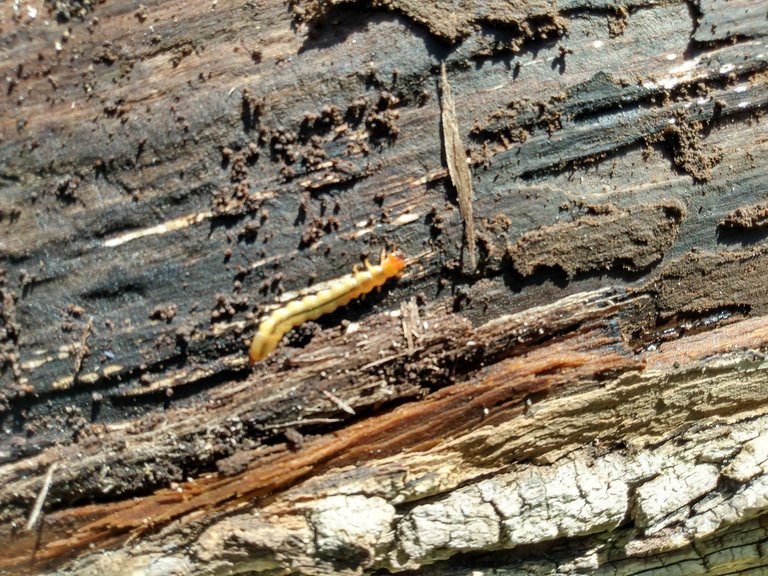If you're a regular reader, you've probably seen this post I made about acquiring and assembling my sawmill. If not, and that sounds interesting to you, go ahead and click that link now, we'll be here when you get back.
Was that fun? Well, then you might want to read about me learning how to use the thing, or the adjustments and maintenance it has required so far (there's a gallery of some fine looking cut lumber in that last one!)
Now that I've cut through all the 'easy' logs I had piled up, it's time to get to some of the less accessible wood. It's hard to tell in the pictures, but these logs were kept off the ground, which means the boards I cut from them will have more strength than most of what I've cut so far. Siding boards cut from the log I move in this post were used on the new chicken tractor.

This pile of logs is around 15'-20' away from the sawmill, and they need to be pulled uphill. Before even beginning to tackle that task, though, the weeds and brush around the logs needed to be cleared. It took a few hours with the string trimmer and brush cutter attachments, as well as some time with the small chainsaw, just to even get at the logs.

Since I was cleaning up in the area, I also gathered up all the old logs from my 'pioneer village', where I built my first kiln. The kiln has long since been reclaimed by nature, but as I get this pile of old logs used up, I'd like to begin rebuilding out here.

Once everything was cleaned up, I gathered what I thought I would need for chains, as well as the come-along, and of course things came up about 2' short. This meant dragging up another 20' length of chain, but this wasn't so bad, since it meant I wouldn't have to operate the come-along from within the middle of the sawmill frame.

I was very fortunate that everything worked out where I could run my chains underneath the sawmill, so I didn't have to move it.

I did have to put some logs under the chains and cables, so they wouldn't dig into the ground. I don't know what the total weight of this log was, but my come-along is rated for 5000 lbs., and it pulled the log out easily.

The cheap locking clip in the picture below won't hold enough weight to be good for much, but it is handy for making little loops like this in the chain. I pull the log as far as can, then run the cable for the come-along back out, and make a new loop in the chain wherever the cable hook ends up.

After resetting the come-along 3 times, I finally have the log out to where I want it... in this direction. That's far enough that I can cut it to length for the sawmill, which will drop a couple hundred pounds off the total weight before I have to set up another anchor chain...

...and drag it another 10', this time directly up the hill. I used some smaller logs as rollers for this part of the adventure. Once the front of the log was up where it needed to be, I was able to swing the back around by hand.

The picture below shows the view from just above my second anchor stump, which is the tall stump in the foreground with all the slender new branches growing out of it. Just to the left of the sawmill head, you can see the log I've been pulling into position. To the right of the sawmill is the remains of my first pile of logs, which is now just scrap, sawdust, and lumber.

Once I get the log pulled into position, the battle is still only half over. This monster is WAY too heavy for me to just pick it up and throw it on the sawmill frame. Using some slab cuts for ramps, and my handy log jack, I was able to roll the log up onto the frame.

Below is a picture of the reason we have so many dead ash trees around here... the emerald ash borer. These nasty looking larvae eat tunnels underneath the bark, effectively de-barking the whole tree, and usually killing it within 3 years. Ash trees grow back pretty fast, and the invasive beetles don't seem to bother the saplings, so I don't think we'll completely lose our ash trees, but it will be a long time before we have full forests of mature ones again.

Once my log is on the sawmill frame, it takes me less time to cut the whole log than it took to move it here, which was about 2 hours. This definitely slows my board-making pace down quite a bit, and I may end up building a frame over the sawmill that allows me to drag logs over quickly with the chain hoist.

We'll see if time allows for that project, or if perhaps I just try moving the sawmill to a location where I could load this second log pile more easily, which was my original plan. I'm sure that I don't want to drag all dozen of these logs over this way, so this is a problem I'll tackle before I cut too many more boards. Whatever happens, I'll be sure to share it with all of you!

